Get PeakVisor App
Sign In
Search by GPS coordinates
- Latitude
- ° ' ''
- Longitude
- ° ' ''
- Units of Length

Yes
Cancel
Share ×

Scan the QR code and open PeakVisor on your phone
❤ Wishlist ×
Choose
Delete
Scale one of the world's most famous volcanoes and discover Roman towns frozen in time when you visit Italy's Vesuvius National Park (Parco Nazionale del Vesuvio). There are 8 named mountains in Vesuvius National Park, the highest and most prominent of which is Vesuvius (Vesuvio) at an elevation of 1,281 m (4,203 ft).
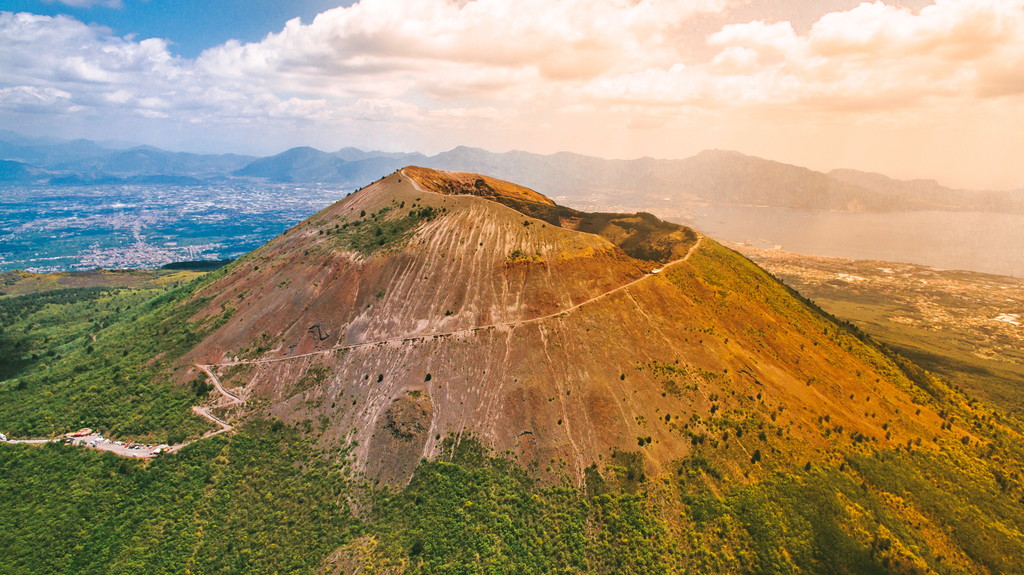
Vesuvius National Park (Parco Nazionale del Vesuvio) overlooks the Gulf of Naples and covers an area of approximately 72.5 sq. km (28 sq. mi). The park is located entirely within the province of Naples (Napoli) in the region of Campania.
Vesuvius National Park is centered around Vesuvius (Vesuvio), one of Europe’s most dangerous volcanoes. Vesuvius' crater, which is known as the Gran Cono, currently has a diameter of 450 m (1,476 ft) and a depth of 300 m (984 ft).
Vesuvius forms part of the Somma–Vesuvius volcanic complex, alongside Monte Somma. Monte Somma is the remains of a volcano that eventually gave rise to the Vesuvius that we know of today.
Monte Somma consists of four peaks. From east to west, they are:
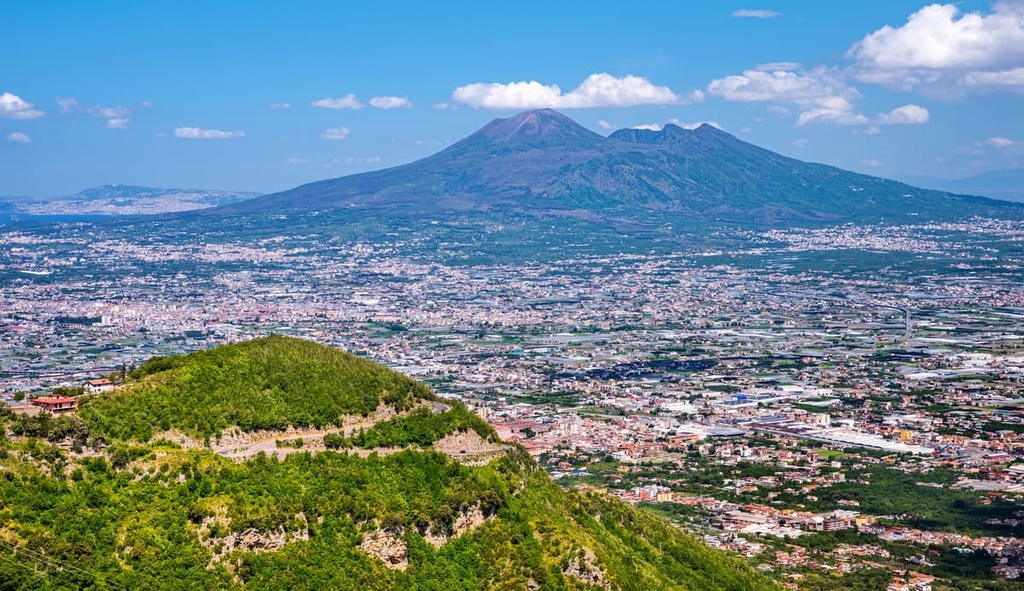
Monte Somma's broken cone forms a semicircle around Vesuvius to the north and northeast. Separating the cones of Vesuvius and Monte Somma is a hollow called Valle del Gigante (Giant’s Valley). Valle del Gigante was a section of a larger ancient caldera out of which Vesuvius formed, likely during the famous eruption of 79 CE.
Despite the national park’s relatively recent volcanic activity, the landscape in the region is quite varied. It ranges from shrublands and mixed forests to lava fields.
The closest national park to Vesuvius National Park is Cilento and Vallo di Diano National Park (Parco Nazionale Cilento, Vallo di Diano e Alburni), which is located approximately 70 km (43 mi) to the southeast.
There are also several regional parks located within 30 km (18.5 mi) of Vesuvius National Park. These regional parks include Monti Lattari Regional Park (Parco Regionale dei Monti Lattari) to the south, Partenio Regional Park (Parco regionale del Partenio) to the northeast, and Monti Picentini Regional Park (Parco Regionale dei Monti Picentini) to the west.
Naples, Italy's third-largest city and the capital of Campania, is located less than 10 km (6 mi) away from Vesuvius. Other notable settlements located near the park include Sorrento, Caserta, Amalfi, and Boscoreale.
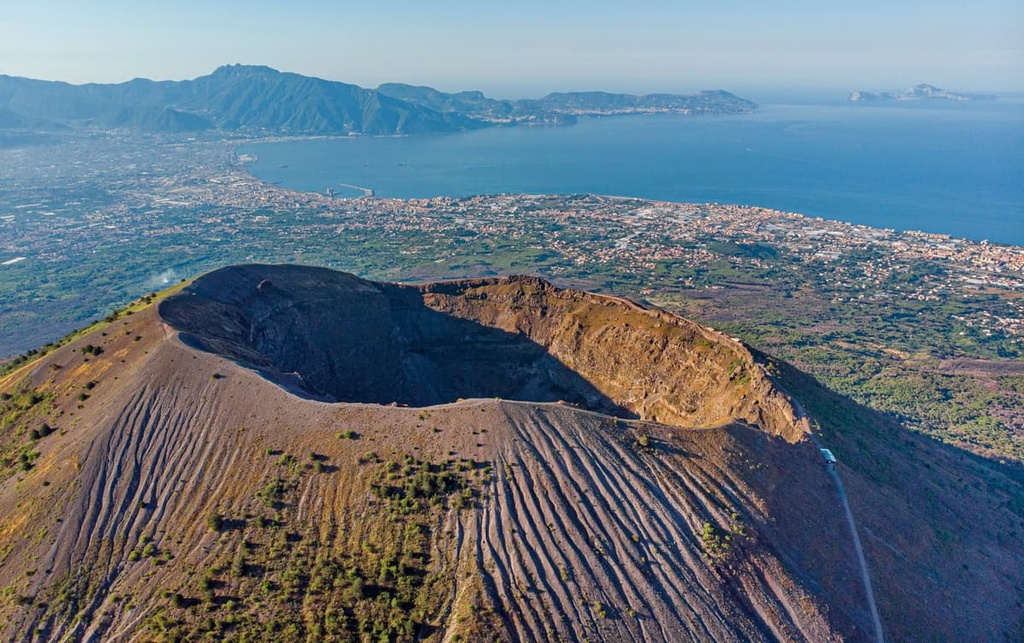
The Somma–Vesuvius volcanic complex is part of the Campanian volcanic arc, which features a mix of dormant, extinct, and active volcanoes, including Mount Epomeo (788 m/2,589 ft) and Campi Flegrei (102 m/334 ft).
This arc formed approximately two million years ago due to the collision of the African and Eurasian plates. The subduction of the African plate pushed watery sediment into the Earth's upper mantle, which boiled off, partially lowering the melting point of the mantle's rocks.
The resulting magma, which was less dense than the surrounding rocks, was subsequently pushed upwards. It eventually broke through weak points in the Earth's surface and created the volcanoes that we see today.
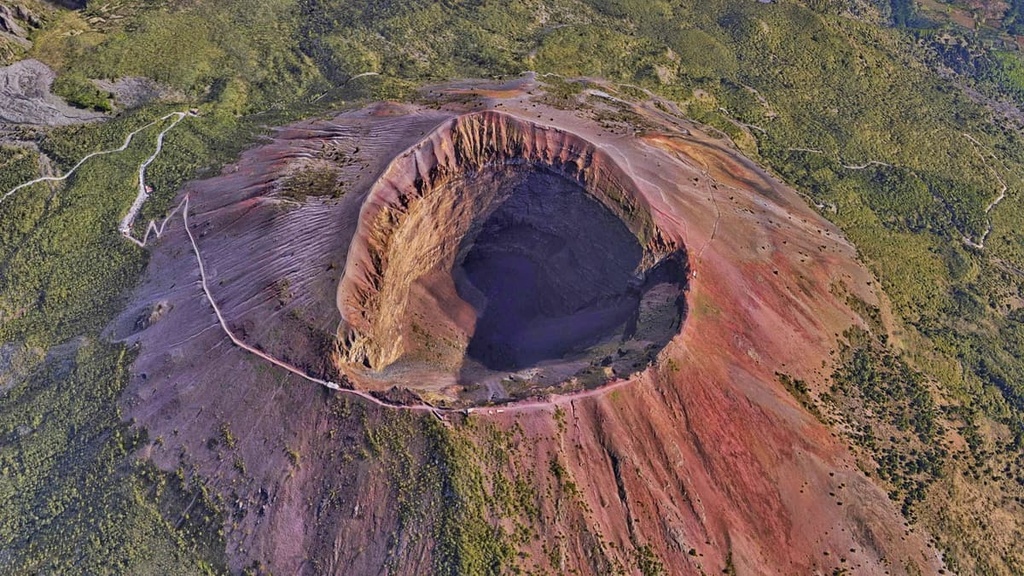
Modern-day Vesuvius is a somma-stratovolcano formed by layers of pyroclastic and volcanic eruptions layered atop one another, creating a conical shape. Volcanic activity at Monte Somma started 400,000 years ago. It was likely destroyed and replaced by Vesuvius at some point during the last 25,000 years.
The largest deposits of pyroclastic sediment in the park are located to the south and southeast of the Somma–Vesuvius volcanic complex. These deposits date back to the famous eruption in 79 CE, which buried the towns of Pompeii and Herculaneum.
The last time Vesuvius erupted was in 1944. It was an effusive eruption, which means it was an eruption during which lava flowed gradually down the volcano. During the eruption, there were also low levels of volcanic gas. The lava flow from 1944 is still visible near San Sebastiano al Vesuvio.
An effusive eruption is the opposite of an explosive eruption, which is a violent eruption that spews toxic gas and causes chunks of rock to fly through the air. Explosive eruptions can be either plinian or subplinian, terms which take their name from Pliny the Younger, who first described such events in written records during the 79 CE eruption of Vesuvius.

Vesuvius National Park is of particular interest to geologists, as it is home to over 260 types of minerals. Of these minerals, six are unique to the area. Many of these 260 minerals are formed by different types of volcanic eruptions. For example, effusive eruptions from the volcano produced augite, leucite, and magnetite, while explosive eruptions produced aragonite, thomsonite, and vesuvianite.
Thanks to its unique volcanic landscape, Vesuvius National Park is very biodiverse and it is home to an array of flora and fauna.
Due to its location near the sea and the fact that it is the only mountain located across the Nola plain from the Apennines, the Somma–Vesuvius volcanic complex is an important stopping point for many migratory birds.
About 150 bird species can be found in Vesuvius National Park. Notable migratory bird species that can be found in the park include marsh harriers, European bee-eaters, and lesser kestrels. Some of the more rare permanent residents of the park include imperial ravens, common rock thrushes, and lesser spotted woodpeckers.

Additionally, 29 different mammal species have been identified in Vesuvius National Park, most of which are nocturnal or crepuscular rodents. The most common mammals in Vesuvius National Park are dormice, garden dormice, and hazel dormice. Foxes are the most common predator, while beech martens and weasels are also prevalent.
Roughly 1,229 species of insect and arthropod inhabit Vesuvius National Park. Five of these species can be found nowhere else in Italy, including the Zelotes denapes (a type of spider) and the Ectobius aeoliensis cockroach.
Common reptiles and amphibians found in the park include Italian wall lizards, green whip snakes, and Mediterranean house geckos.
Vesuvius National Park is home to approximately 744 plant species. Maquis shrubland covers large areas of the park. This shrubland is characterized by thick, evergreen shrubs that don't exceed 5 m (16 ft) in height. Maquis shrublands within the park consist mainly of three species of broom: Spanish broom, Etna broom, and Scotch broom.
Italy has one of the highest concentrations of orchid species worldwide, with over 100 species found within its borders. Approximately 19 orchid species can be found within Vesuvius National Park. Notable examples include naked-man orchids, early spider orchids, and pink butterfly orchids.
That said, thousands of years of agriculture in the region have affected the plant life found across what is now Vesuvius National Park. The ancient Greeks introduced vines to Campania around 3,000 years ago, and now many grape varieties, such as Piedirosso and Caprettone, are widespread across the greater Vesuvius region.
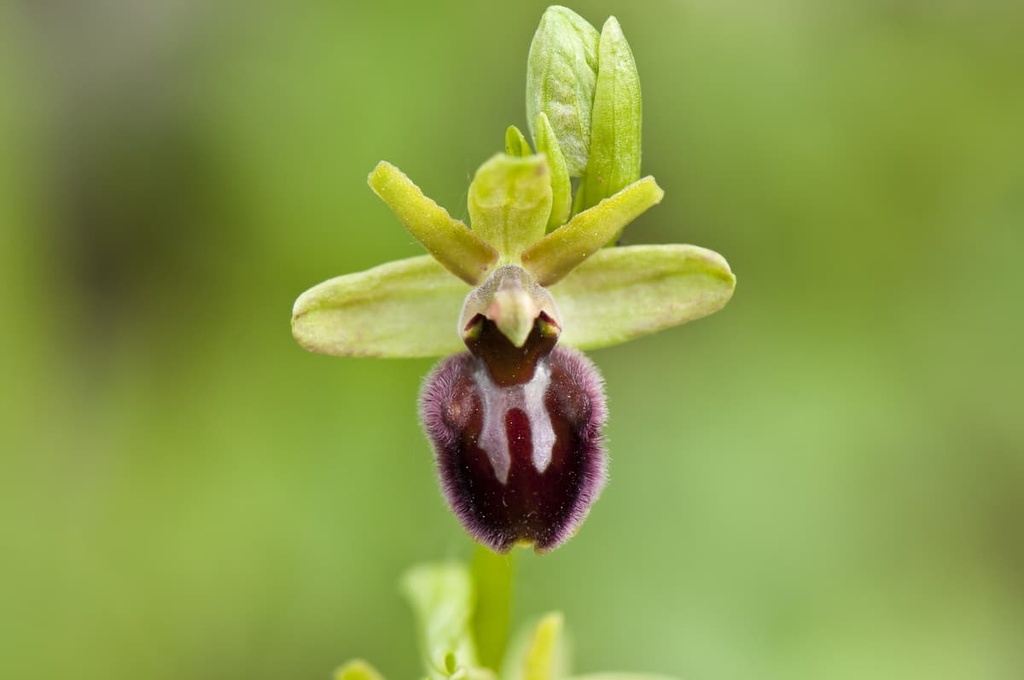
Vesuvius National Park is also home to famous apricot orchards and the Vesuvius tomato vines. Other cultivated plants include cherry trees, apple trees, and fennel. You can also find more than 200 mushroom species within Vesuvius National Park, including honey fungus, latticed stinkhorn, and dark cep.
Humans have inhabited the area surrounding Vesuvius since at least the Neolithic period. The Ancient Greeks founded Naples in the first millennium BCE. Meanwhile, stable settlements that grew into Pompeii and Herculaneum date back to the eighth century BCE and were constructed by the Oscans.
Violent volcanic eruptions have shaped the human history of Vesuvius National Park. Vesuvius became what is arguably the most famous volcano on the planet after the rediscovery and excavation of a perfectly-preserved Pompeii by archeologists.
By 79 CE, Pompeii had a population of around 20,000 people. The famed eruption of Vesuvius that destroyed the town lasted for two days and is believed to have taken place between August and November. The first 18 hours of the eruption consisted of pumice rain, which allowed most of the inhabitants to escape.
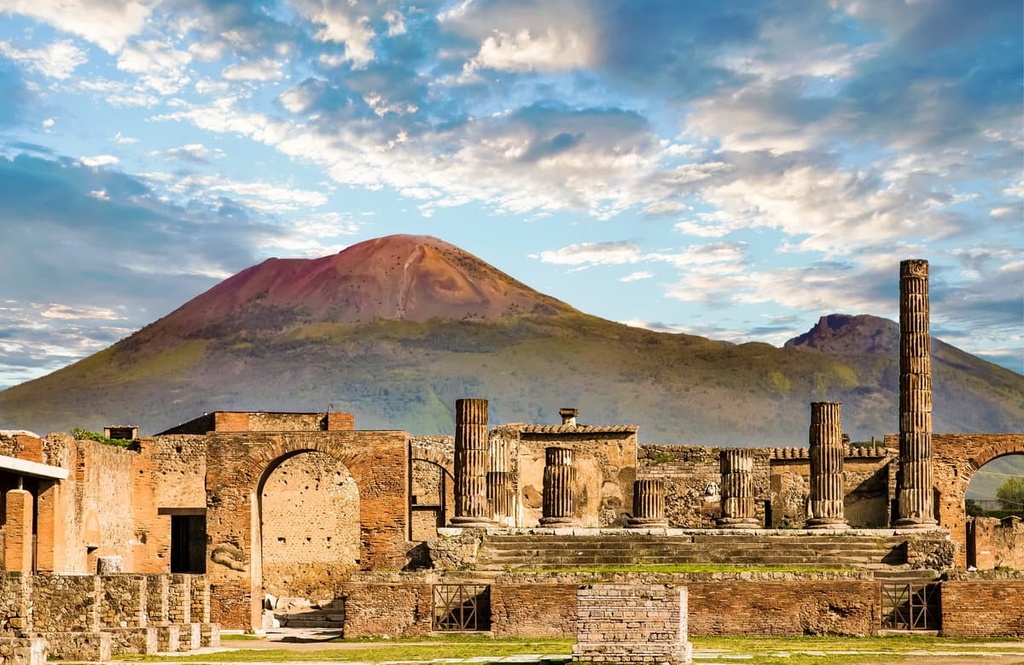
Only around 1,150 bodies have been uncovered in Pompeii. Most people died due to exposure to pyroclastic flows that were over 250 degrees Celsius (480 degrees Fahrenheit) in temperature.
Pliny the Younger famously documented the destruction of Pompeii from Misenum across the Bay of Naples. Volcanologists consider Pliny the Younger's account of the eruption as one of the earliest and most important written accounts of an explosive volcanic eruption.
Pliny the Younger's uncle, Pliny the Elder, died during the eruption. An admiral in the Imperial Navy, he had set sail across the Bay of Naples to help evacuate people. Remarkably, he stopped on the way in Stabiae, 4.5 km (2.7 mi) from Pompeii, to take a nap and eat.
Many attempts were made throughout history to uncover the ruins of Pompeii. It's the longest continually excavated archeological site in the world.

Herculaneum was rediscovered by workers in 1738 who were building a summer palace for the King of Naples, Charles of Bourbon. It wasn't until 1748 that Spanish military engineer Roque Joaquín de Alcubierre uncovered a Pompeii that was frozen in time.
Pompeii gives archeologists an unprecedented insight into Roman life and city planning. Modern excavations have uncovered thermopolia, or snack bars selling heated food, in the town that are considered to be a very early form of what we know now as fast-food establishments. Other discoveries in Pompeii include vibrant and well-preserved frescoes.
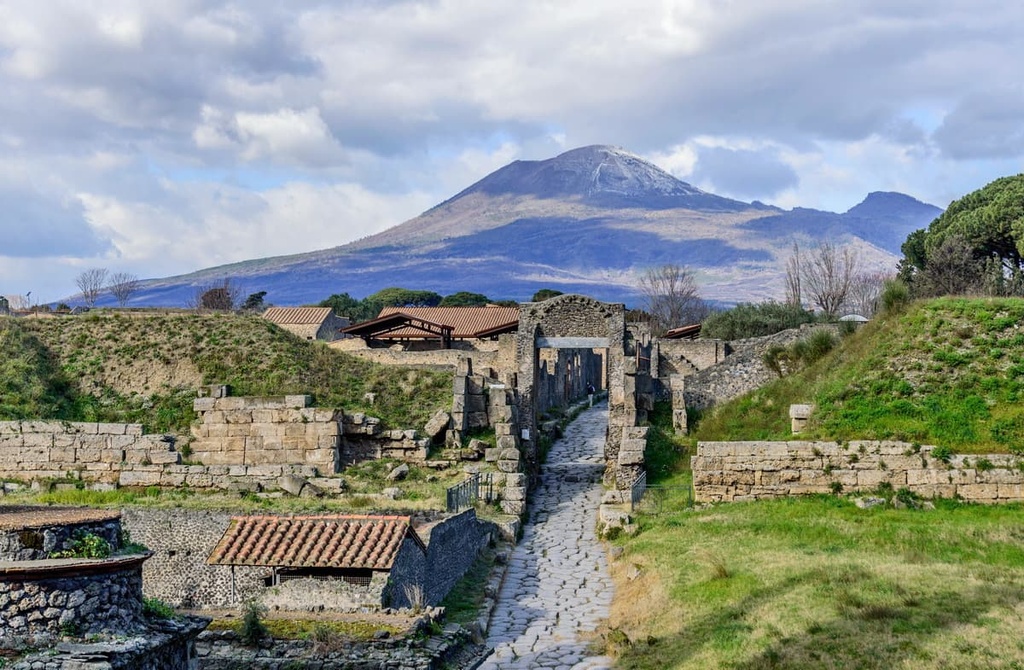
Vesuvius has erupted several times since the beginning of the twentieth century. In 1906, an eruption killed around 100 people, damaging Naples and hampering preparations for the 1908 Summer Olympics.
Between 1913 and 1944, Vesuvius was particularly active. This activity ended with a violent eruption in March 1944, which destroyed the villages of San Sebastiano al Vesuvio, Massa di Somma, and Ottaviano.
Today, Vesuvius is considered to be one of the most dangerous volcanoes in the world, as three million people live close enough to be affected by an eruption. It's also one of the only volcanoes in Europe to have erupted in the last century.
The Italian government designated the Somma-Vesuvius volcanic complex a national park on June 5, 1995. There are maintained trails in the park, and visitors can climb up the summit crater.
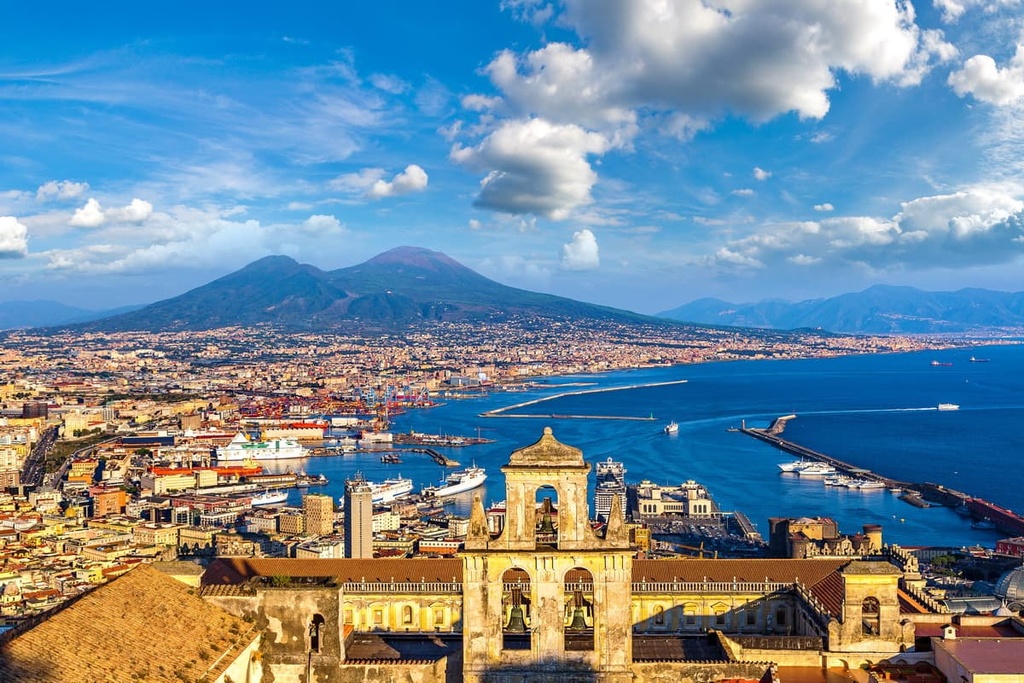
Nowadays, Vesuvius is also a very famous wine-producing region. The wine produced in the region is crafted from grapes grown in the rich volcanic soils on the slopes of Mount Vesuvius itself. There are a number of vineyards located on the mountain, many of which produce a type of wine called Lacryma Christi.
Lacryma Christi is made from a blend of a number of grape varietals including Caprettone. Many archaeologists believe that it is also one of the closest equivalents we have to the wine that the ancient Romans in the region would have drunk as is evidenced by studies of the ancient wine casks uncovered in the area.
Vesuvius National Park is home to 11 hiking paths with a total length of 54 km (33.5 mi). Before setting out on your hike, ensure you check local weather conditions and bring appropriate footwear. You should also check if any trails are closed for maintenance. You can find details about Vesuvius’ trail closures on the park's website.
Read on to learn about the best hiking trails in Vesuvius National Park.
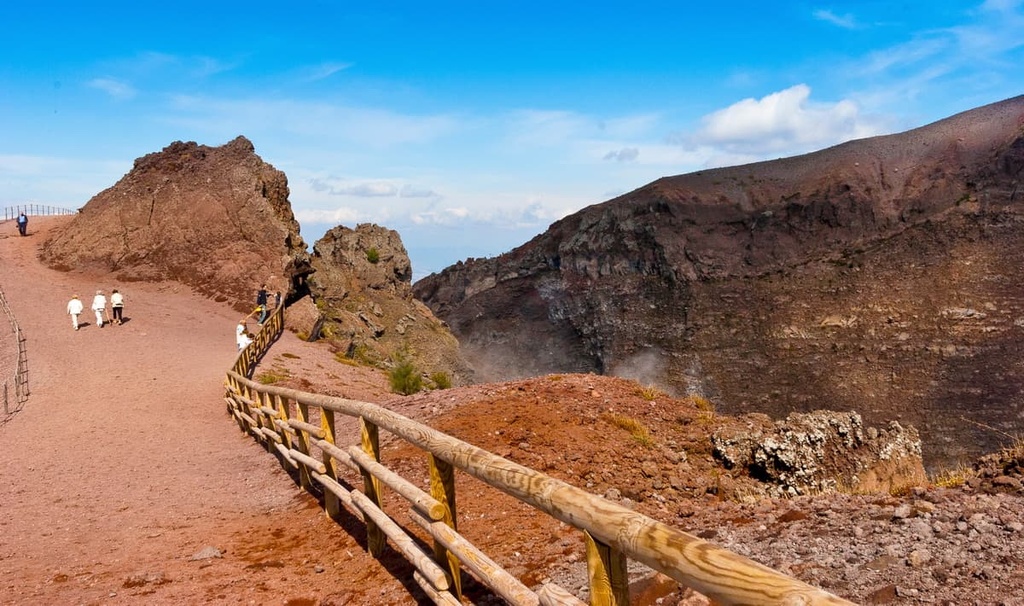
The walk up to and around the rim of Vesuvius' crater is the park's most exciting and rewarding hike.
Hikers should note that there is a €10 fee for tickets to reach the crater. Only Consorzio Arte'm provides tickets, and you can only book online. You can find more information on the park's website. The crater is only open between certain hours, which change throughout the year, so plan ahead and do your research to avoid disappointment.
The walk up to the Gran Cono is 4 km (2.5 mi) in length and takes around 2 hours and 30 minutes to complete. Despite taking hikers to the park’s highest point, this walk is one of the shortest and easiest in the park.
The path is signposted as Sentiero number 5 and starts from the Piazzale di Quota 1000 parking area. Note that parking at Piazzale di Quota 1000 is currently unavailable so you will need to find another way to the trailhead.
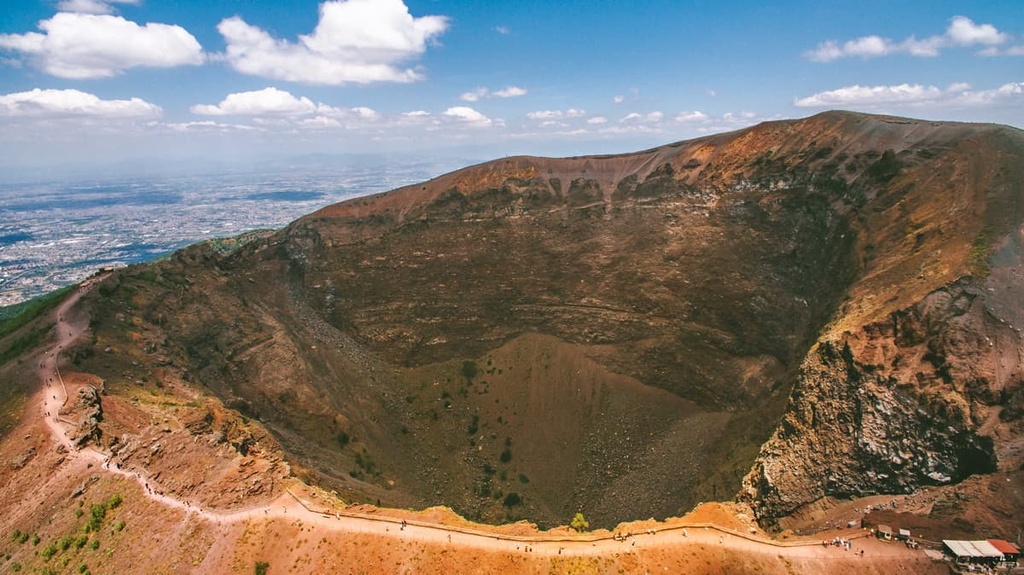
The Sentiero number 5 is a wide path that zigzags up Vesuvius. As you climb, you'll have great views of the Gulf of Naples, the Tirone Alto-Vesuvio Nature Reserve, and Colle Umberto (886 m/2,907 ft) in the distance.
After passing the ticket booth at a height of 1,118 m (3,668 ft), you'll be able to walk around the edge of the crater, where you can enjoy spectacular views of the rest of Monte Somma and Naples.
This walk in the Valle dell'Inferno (Valley of Hell) takes visitors through some of the park's finest environments, from shrublands to lava fields.
This trail is signposted as Sentiero number 1. Much of the start of this hike follows the same path as the number 2 trail, which is called Lungo i Cognoli.
You can pick up the trail from 4 km (2.5 mi) outside Ottaviano on the road that leads to Monte Somma. Along the way, you'll pass the beautiful seventeenth-century Medici Palace. Today, the palace houses Vesuvius National Park’s headquarters.
The Valle dell'Inferno walk is approximately 12.3 km (7.6 mi) in length and takes around 7 hours and 30 minutes to complete. It’s considered a challenging walk due to its length.
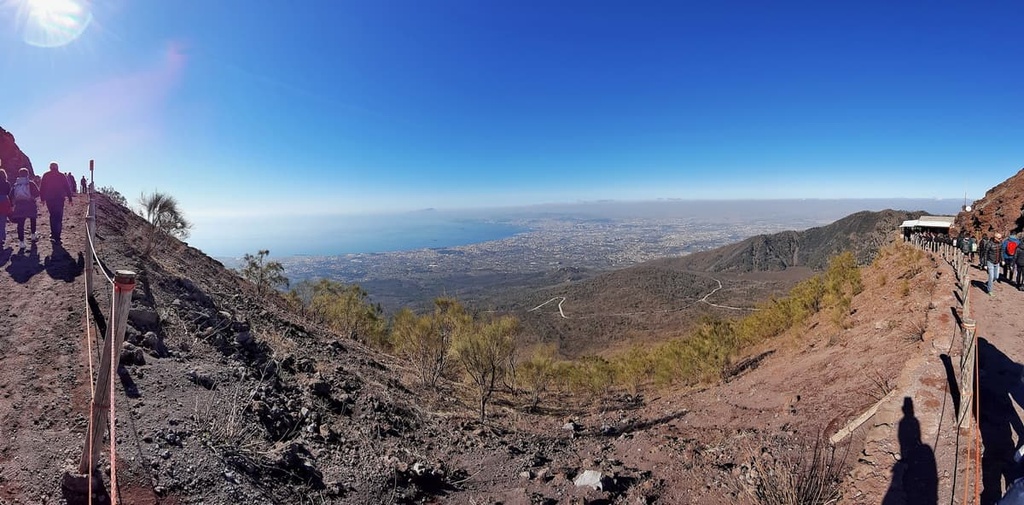
The path leads through mixed forests of alders, chestnuts, and oaks. These areas are some of the best places to see some of the park’s many rare bird species, including lesser spotted woodpeckers.
On this hike, you'll skirt the lava dome of the Cupola 1937 (838 m/2,749 ft) before passing into the Valle dell'Inferno, which features otherworldly lava walls and spires. The Maquis scrublands here are also great for seeing peregrine falcons, common ravens, and common rock thrushes.
The path then returns back down the mountain via the Cognoli di Levante before leading you back to your starting point.
The Lungo i Cognoli (Along the Cognoli) Trail offers some of the best views of the Somma-Vesuvius volcanic complex, as it gives you a chance to take in all aspects of the park's landscape. Note that sections of this trail are currently closed from Somma Vesuviana.
This path follows the Sentiero number 2 and starts from the Medici Palace. The walk is approximately 8.1 km (5 mi) in length and takes around 8 hours and 30 minutes to complete. It's considered a challenging hike due to the steepness of the terrain.
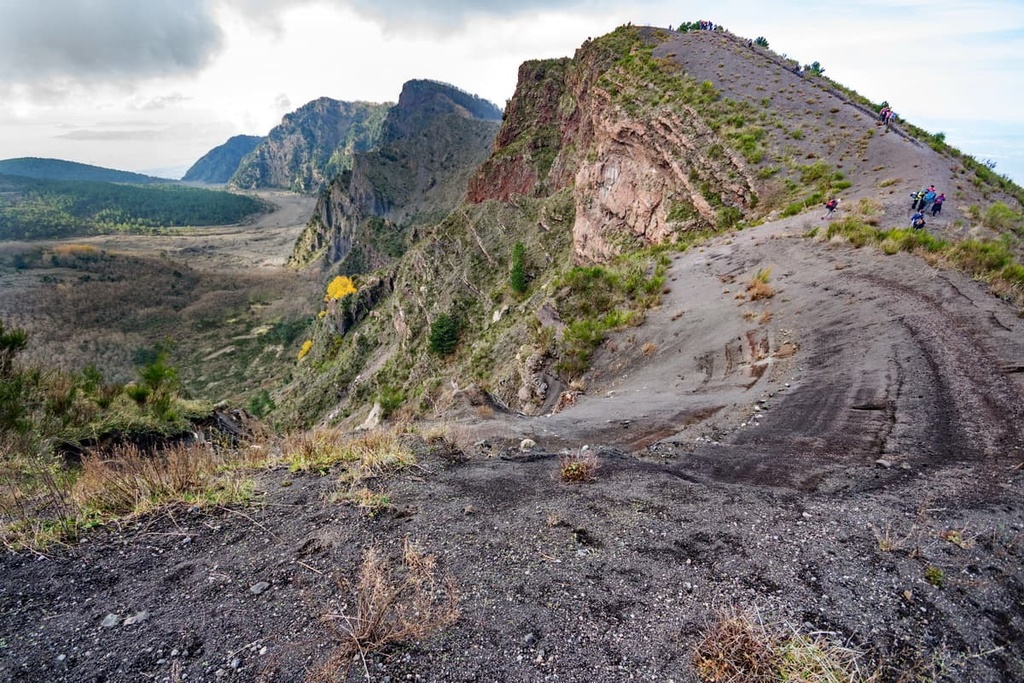
The start of the walk follows the same route as Sentiero number 1 before deviating to the right after 1 km (0.6 mi) at Largo Angelo Prisco. After passing through woodlands, the path leads to the left, avoiding Punta Nasone (1,131 m/3,711 ft).
Soon you'll reach the summit of Cognoli di Ottaviano (1,112 m/3,648 ft), which affords panoramic views of Monte Somma and Vesuvius. The path then leads along an undulating ridge before descending steeply into Valle dell'Inferno (Valley of Hell).
The descent from Monte Somma is the same as Sentiero number 1. It will return you to your starting point via the Cognoli di Levante.
This circular trail leads to the highest point of Monte Somma, Punta Nasone (1,131 m/3,711 ft). It's also one of the most challenging hikes in the park due to its length and elevation gain. Note that sections of this path from Somma Vesuviana may be under maintenance.
This path is signposted as being part of Sentiero number 3. It starts from the ancient road Via Traversa, which leads towards Colle Umberto (886 m/2,907 ft) from the Vesuvius Observatory. The hike is around 7.6 km (4.7 mi) in length and takes approximately 5 hours and 30 minutes to complete.
The walk starts by ascending the Cognoli di Giacca before weaving through woodlands and climbing steeply to Punta Nasone. From the summit, you'll have excellent views of the Valle del Gigante (Giant’s Valley), where a lava river flowed in 1944.
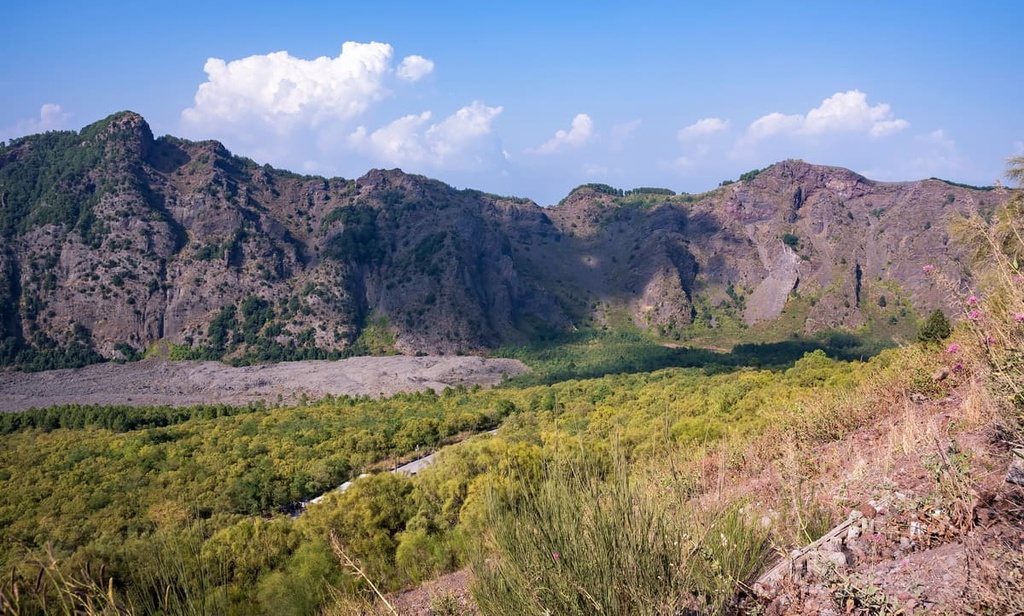
You'll then continue onto the Cognoli di Sant'Anastasia (1,086 m/3,563 ft), where there are views of the Gulf of Naples. Finally, you'll descend to Cognoli di Trocchia (971 m/3,186 ft) before returning to your starting point.
Hikers looking to discover the rare nature of Vesuvius National Park should visit the Tirone-Alto Vesuvius Forest Reserve.
Located on the park's western boundary, this nature reserve is home to rare plants such as Orchis serapias cordera and Orchis morio. One of the most interesting animals in the reserve is the nonvenomous Aesculapian snake, which is among Europe's largest snakes.
This trail through the forest reserve follows Sentiero number 4, and it starts to the south of the Vesuvius Observatory. It's approximately 11.2 km (7 mi) in length and takes around 6 hours to complete.
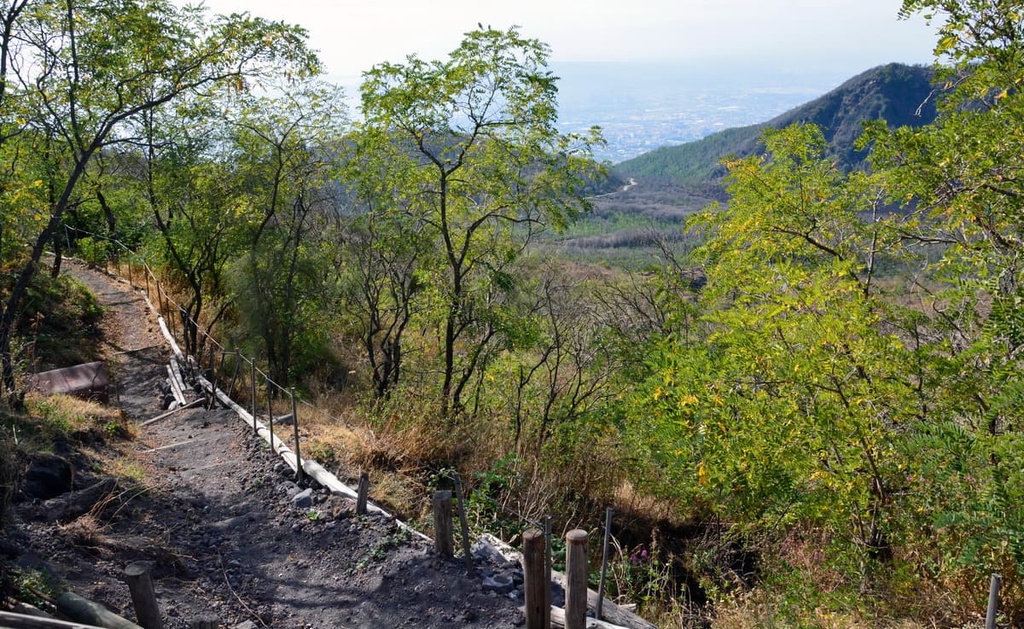
The path is relatively flat, and it's possible to shorten the walk significantly by looping back once you reach Baracche Forestali. If you continue onward, you'll follow a section of Sentiero number 6 Strada Matrone, where you can admire the remains of the lava river from the 1944 eruption.
With over three million people living within 30 km (18 mi) of Vesuvius, you won't be short of exciting and lively places to stay during your trip to the region. Read on to learn about some of the best major cities and towns to check out the next time you’re in the area.
The third-largest city in Italy, Naples, is within easy driving or train distance of Vesuvius. Sat on the glistening Gulf of Naples, Naples is famed for its Neapolitan cuisine, Baroque artistry, and ancient history.
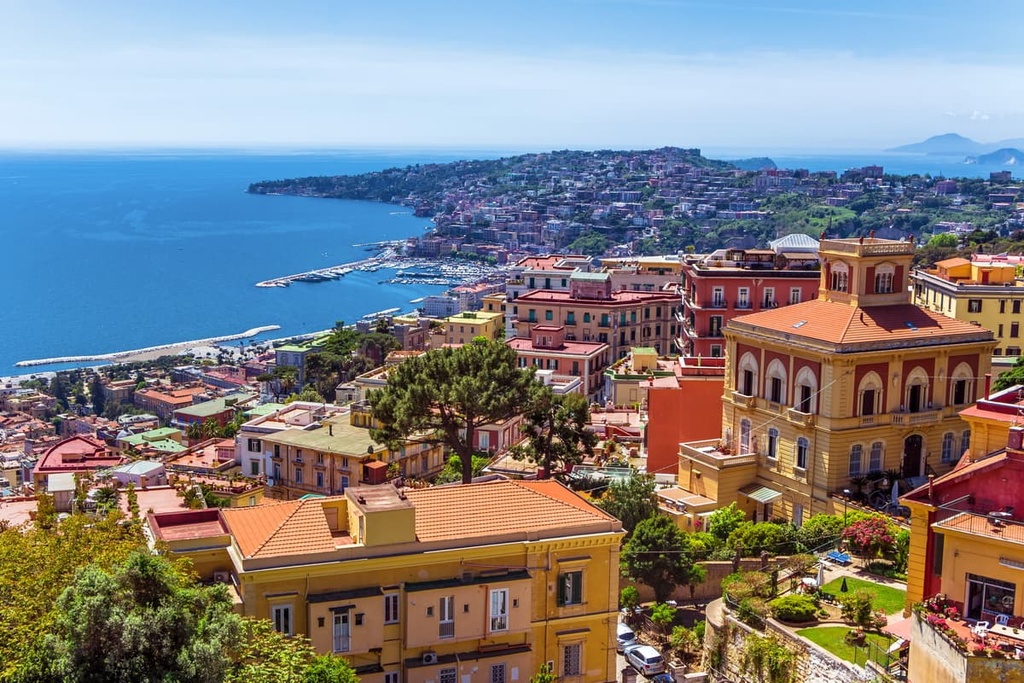
During your stay in Naples, ensure you visit some of the city's remarkable buildings, like the Royal Palace of Naples, Ovo Castle, and Castel Nuovo. As well as touring Pompei, you'll want to head to Ercolano to see the preserved ruins of Herculaneum.
You can easily get to Naples by road or rail from Rome where there’s a major international airport. Naples also has its own international airport as well as great train connections to the national park and the surrounding region. Once you arrive, there's no shortage of high-quality hotels in Naples to choose from, including Hotel Royal Continental, Relais Della Porta, and Hotel Piazza Bellini.
The town of Sorrento is perched on the end of the Sorrentine Peninsula about 50 km (31 mi) away from Vesuvius National Park. One of the most beautiful towns in Campania, Sorrento offers sweeping views of Naples, Vesuvius, and Capri.
While in Sorrento, pay a visit to the striking Vallone dei Mulini, a collection of abandoned historic mills in a narrow valley. You'll also want to take a trip down Amalfi Drive, one of the finest driving roads in Europe, and visit some postcard-perfect towns along the Amalfi Coast, including Amalfi and Vietri sul Mare.
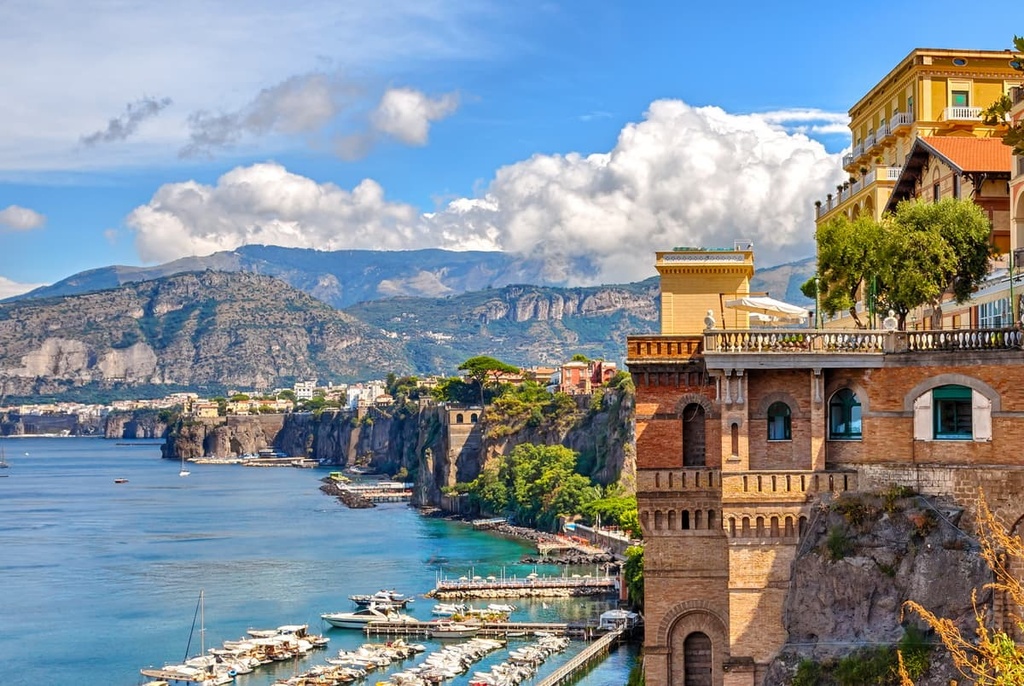
There’s a bus that goes from Sorrento to Amalfi that’s well worth taking if you want to avoid driving down the windy road on your own or if you simply want to be able to take pictures of the surrounding landscape along the way. You can pick up the bus from a stop near the Sorrento train station, which you can get to easily from Naples and Vesuvius.
Popular hotels in Sorrento to check out include Hotel Plaza Sorrento, Hilton Sorrento Palace, and Grand Hotel La Favorita.
Visitors looking to avoid bustling tourist hotspots but who still want to enjoy beautiful beaches, delicious cuisine, and rich Roman heritage should stay in Salerno.
Located at the base of the Sorrentine Peninsula overlooking the Gulf of Salerno, Salerno offers attractions like the medieval Salerno Cathedral, the vibrant Giardino della Minerva, and the hilltop Castello di Arechi.

Plus, Salerno is less than an hour's drive from Vesuvius National Park. Popular hotels in Salerno include Grand Hotel Salerno, Hotel Montesella, and Medditeranea Hotel.
Situated on the edge of the Campanian Plain some 35 km (22 mi) to the north of Naples is the city of Caserta. A provincial capital, Caserta is famed for being home to the Royal Palace of Caserta, a UNESCO World Heritage Site and the largest palace built in Europe during the eighteenth century.
The Royal Palace is one of Campania's top attractions. It has been featured in several movies, including Star Wars: Episode One – The Phantom Menace. When you're not touring the palace, consider visiting the Aqueduct of Vanvitelli or the Cathedral of Saint Michael Archangel.
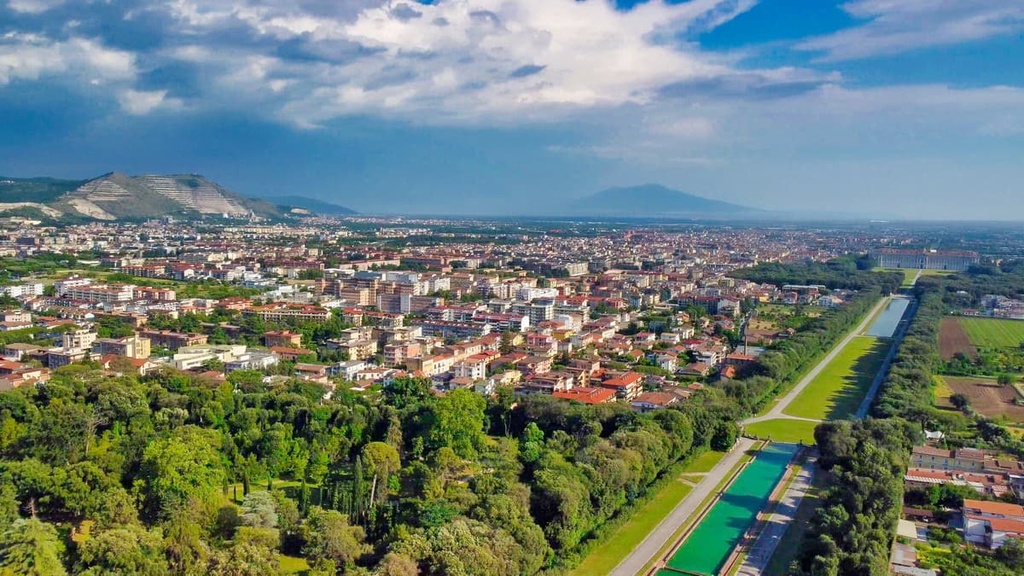
Popular hotels in Caserta include Royal Caserta, Plaza Caserta, and Grand Hotel Vanvitelli.
From Conca dei Marini to Ravello, the Amalfi coast is lined with countless picturesque towns. One of the finest such towns is the coast’s namesake, Amalfi.
Located at the mouth of a gorge, Amalfi is surrounded by rugged cliffs that add to its architectural beauty. And there's no shortage of stunning buildings in Amalfi to enjoy, including the ninth-century Duomo di Amalfi and the Moorish Chiostro del Paradiso.
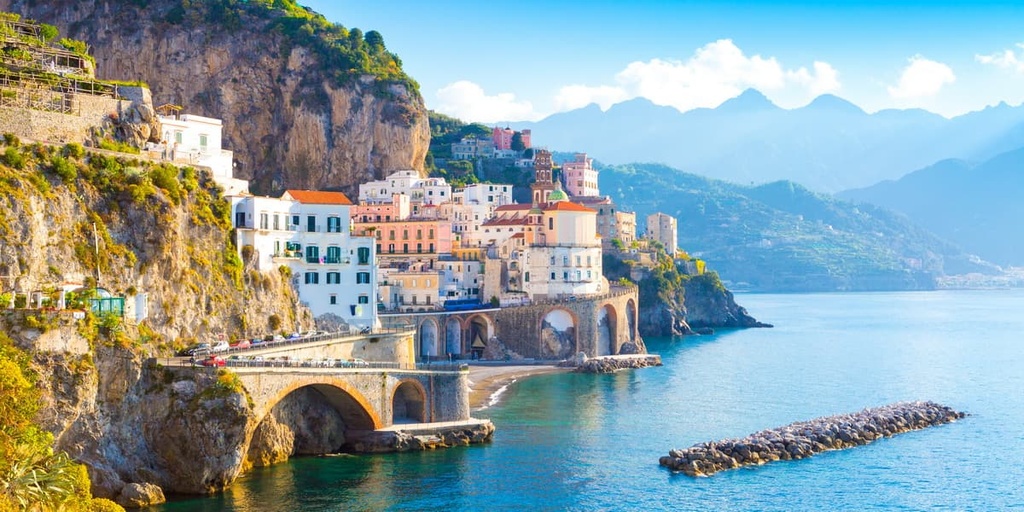
A popular tourist destination, Amalfi is home to seafront hotels like Hotel La Bussola, Santa Caterina Hotel, and Hotel Luna Convento. Trains unfortunately do not run to Amalfi, but you can get here by car or by bus from Sorrento.
Hikers searching for somewhere to stay within Vesuvius National Park should consider Boscoreale. Located on the southern slopes of Vesuvius, Boscoreale offers easy access to the park's hiking trails and the ruins of Pompeii.
The Antiquarium of Boscoreale is well-worth visiting as it houses many Roman artifacts from the nearby Villa Regina archeological site. If you're looking to stay in Boscoreale, consider the Vesuvio Inn or Hotel Ristorante La Vela.
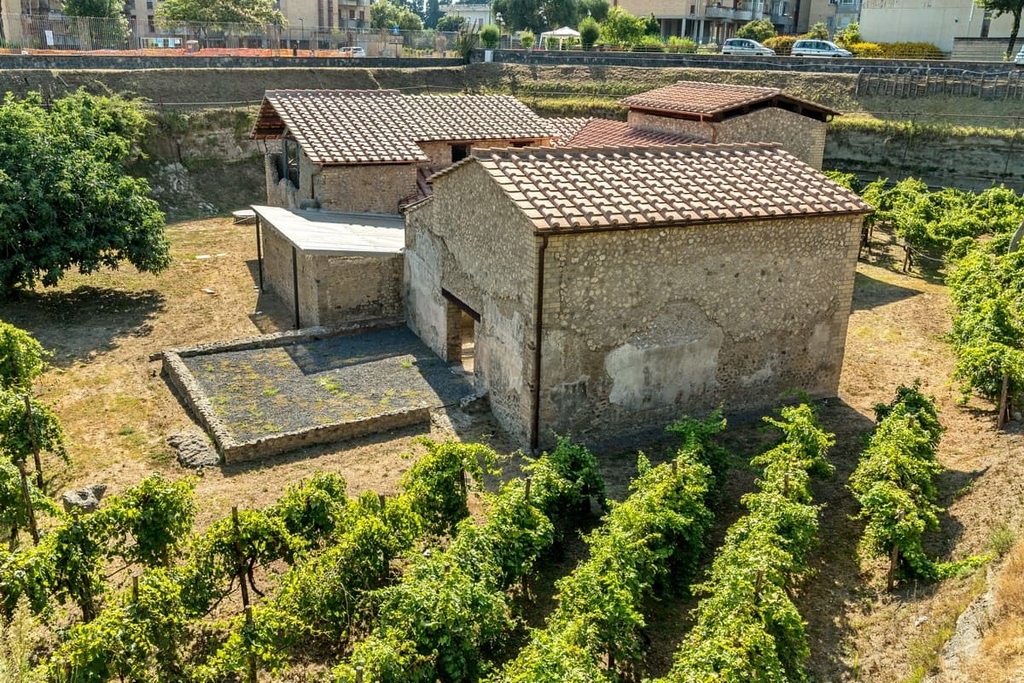
Vesuvius National Park is very conveniently located due to its central location between Napoli and Sorrento. You can easily get around the region via public transport due to the great network of buses and trains in this part of Italy.
If you’re coming from Rome, you can travel to Naples by road or rail. You can also fly directly into Naples from many major airports in Europe. Naples serves as the transportation hub of the region and it is located just to the northwest of the park. From Naples, you can take the trains all the way south along the coast to Sorrento.
To visit Pompei, you can take the trains to the Pompei Scavi station. There’s also a network of train lines called the Circumvesuviana that completely circumnavigates the base of Mount Vesuvius and Vesuvius National Park, so you’re likely to find a stop that leads close to your preferred hiking destination.
Keep in mind that you may not be able to get to all of the region’s hikes or vineyards solely by public transportation. There are many taxi services in the area, however, if you do not have a rental car. Some local vineyards in the park also offer pickups from train stations if you book a wine tasting and tour in advance.
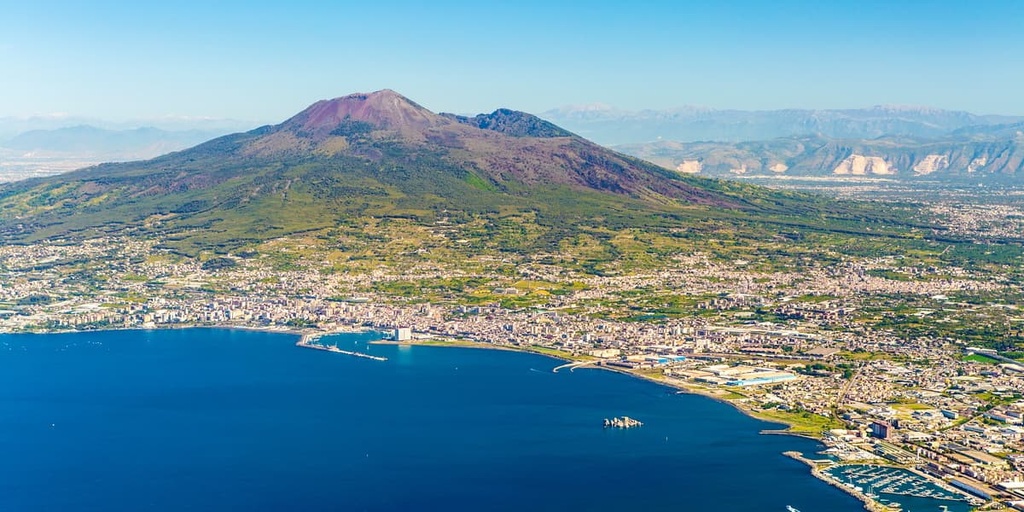
Explore Vesuvius National Park with the PeakVisor 3D Map and identify its summits.








